SMEs, Entrepreneurship, and Small Business Management Analysis
VerifiedAdded on 2020/04/13
|14
|3490
|36
Report
AI Summary
This report delves into the world of Small and Medium Enterprises (SMEs) in Hong Kong, analyzing the business profile of QB House, a haircutting service provider. It explores the meaning of entrepreneurship, differentiating between entrepreneurs and intrapreneurs, and outlining the characteristics of effective entrepreneurship. The report includes a financial analysis, a SWOT analysis of QB House, and an examination of the impacts and illustrations of SMEs in Hong Kong. It discusses the role and contribution of SMEs to the Hong Kong economy, the skill sets required for establishing a SME, and the personal characteristics of entrepreneurs. Furthermore, the report outlines objectives, planning, and strategies for SMEs, as well as the rewards and risks associated with starting a business, including strategies for mitigating these risks. The report concludes with a summary of the key findings and recommendations for SMEs in Hong Kong.
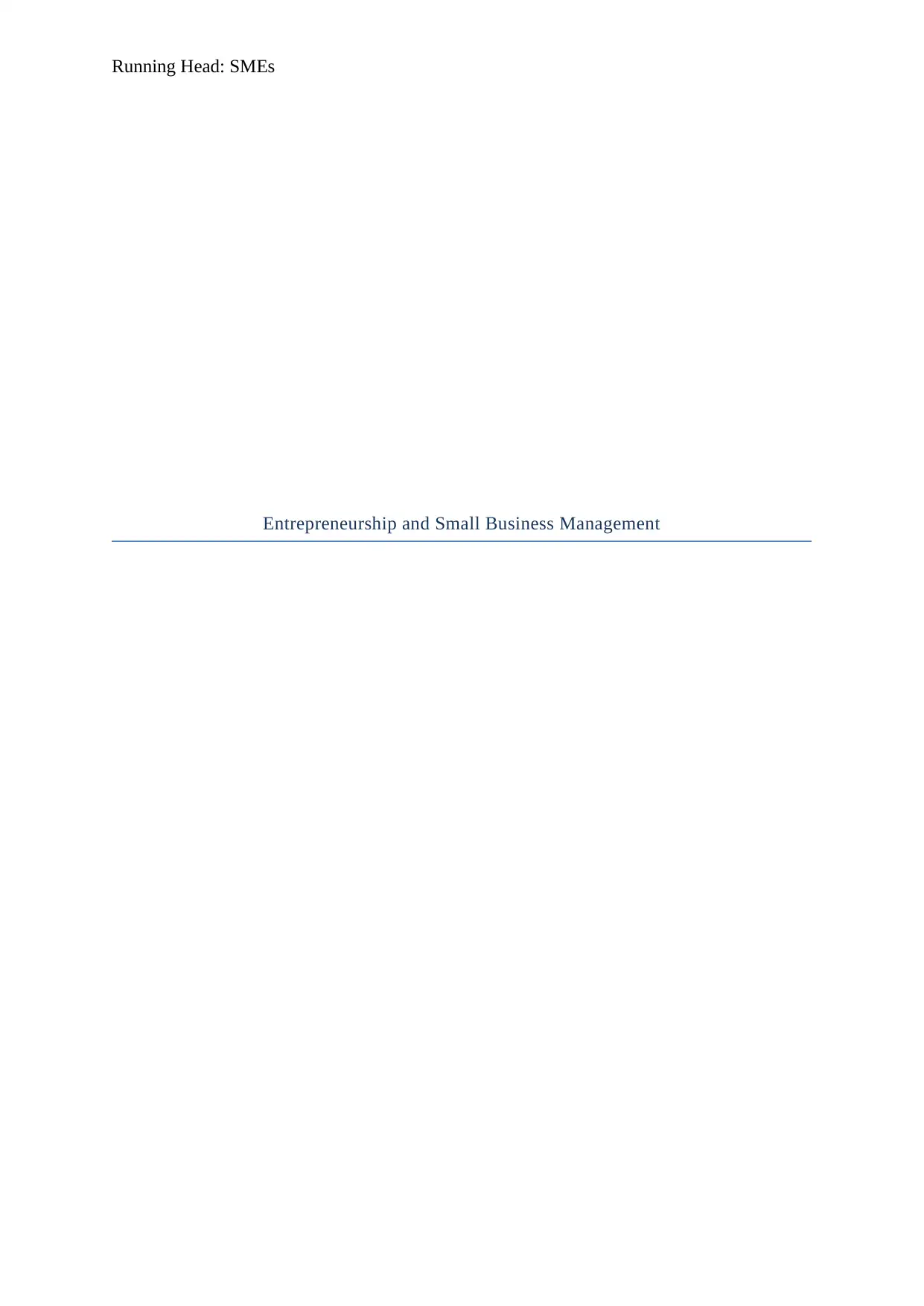
Running Head: SMEs
Entrepreneurship and Small Business Management
Entrepreneurship and Small Business Management
Paraphrase This Document
Need a fresh take? Get an instant paraphrase of this document with our AI Paraphraser
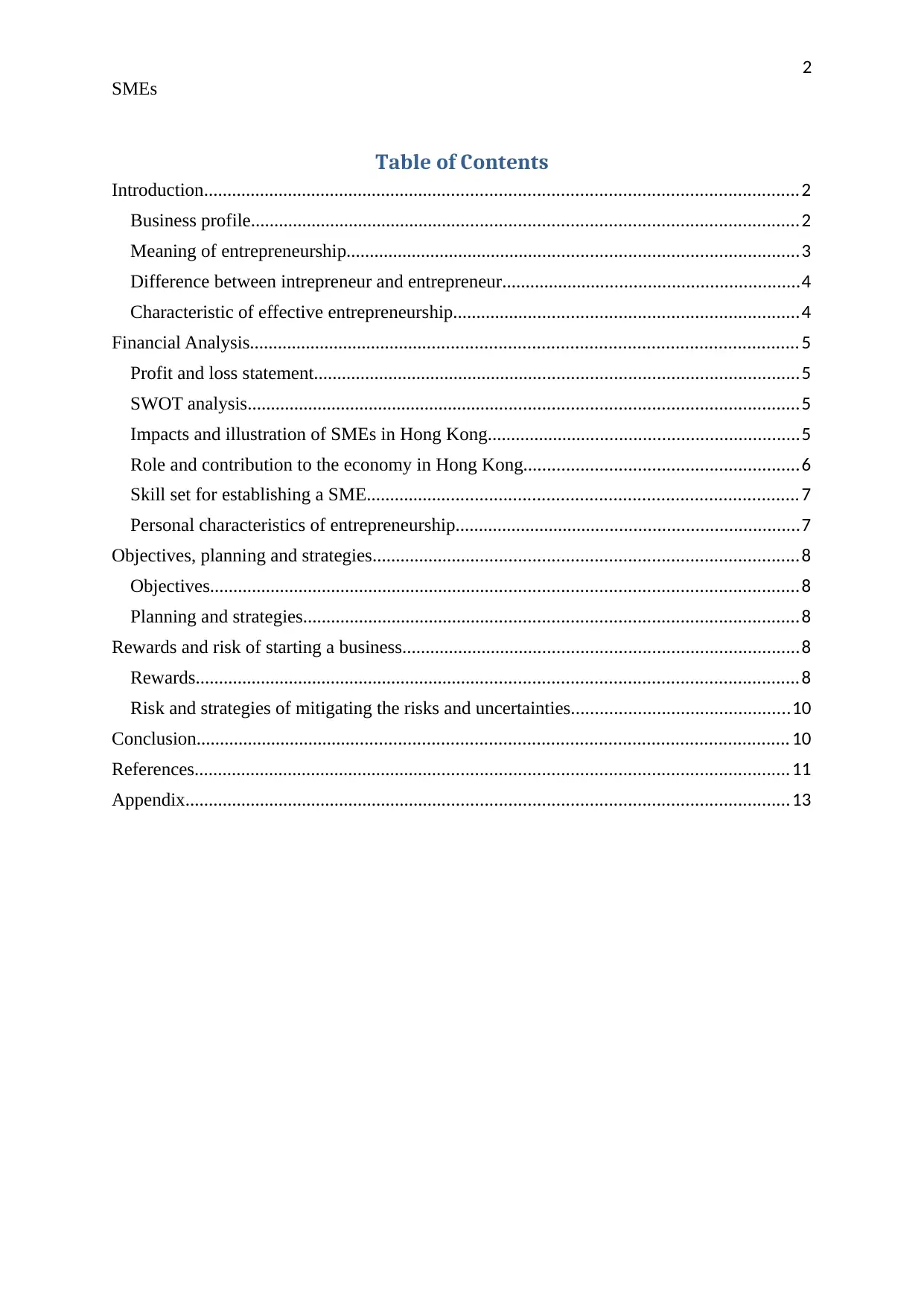
2
SMEs
Table of Contents
Introduction..............................................................................................................................2
Business profile....................................................................................................................2
Meaning of entrepreneurship................................................................................................3
Difference between intrepreneur and entrepreneur...............................................................4
Characteristic of effective entrepreneurship.........................................................................4
Financial Analysis.................................................................................................................... 5
Profit and loss statement.......................................................................................................5
SWOT analysis.....................................................................................................................5
Impacts and illustration of SMEs in Hong Kong..................................................................5
Role and contribution to the economy in Hong Kong..........................................................6
Skill set for establishing a SME........................................................................................... 7
Personal characteristics of entrepreneurship.........................................................................7
Objectives, planning and strategies..........................................................................................8
Objectives.............................................................................................................................8
Planning and strategies.........................................................................................................8
Rewards and risk of starting a business....................................................................................8
Rewards................................................................................................................................8
Risk and strategies of mitigating the risks and uncertainties..............................................10
Conclusion............................................................................................................................. 10
References.............................................................................................................................. 11
Appendix................................................................................................................................ 13
SMEs
Table of Contents
Introduction..............................................................................................................................2
Business profile....................................................................................................................2
Meaning of entrepreneurship................................................................................................3
Difference between intrepreneur and entrepreneur...............................................................4
Characteristic of effective entrepreneurship.........................................................................4
Financial Analysis.................................................................................................................... 5
Profit and loss statement.......................................................................................................5
SWOT analysis.....................................................................................................................5
Impacts and illustration of SMEs in Hong Kong..................................................................5
Role and contribution to the economy in Hong Kong..........................................................6
Skill set for establishing a SME........................................................................................... 7
Personal characteristics of entrepreneurship.........................................................................7
Objectives, planning and strategies..........................................................................................8
Objectives.............................................................................................................................8
Planning and strategies.........................................................................................................8
Rewards and risk of starting a business....................................................................................8
Rewards................................................................................................................................8
Risk and strategies of mitigating the risks and uncertainties..............................................10
Conclusion............................................................................................................................. 10
References.............................................................................................................................. 11
Appendix................................................................................................................................ 13
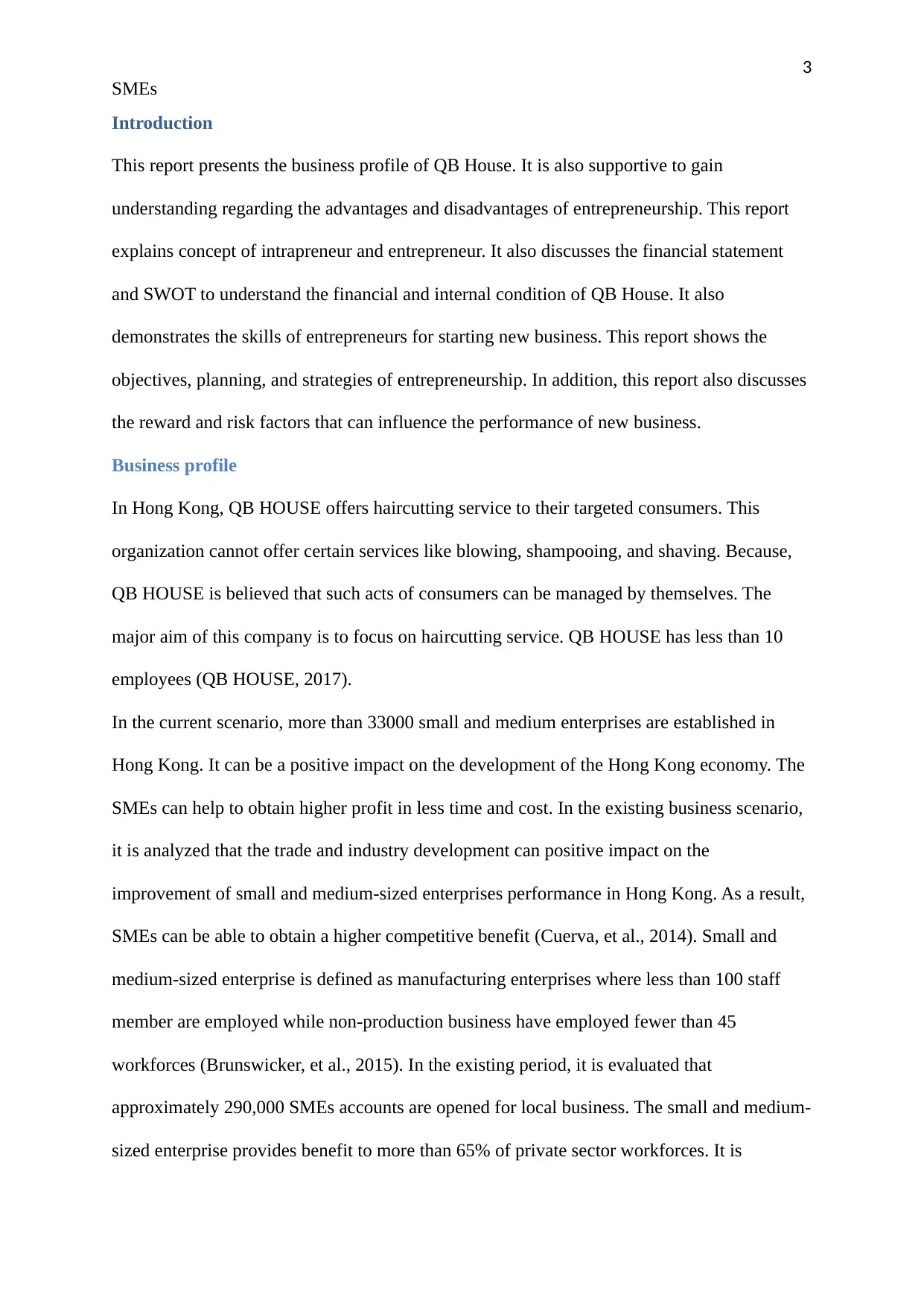
3
SMEs
Introduction
This report presents the business profile of QB House. It is also supportive to gain
understanding regarding the advantages and disadvantages of entrepreneurship. This report
explains concept of intrapreneur and entrepreneur. It also discusses the financial statement
and SWOT to understand the financial and internal condition of QB House. It also
demonstrates the skills of entrepreneurs for starting new business. This report shows the
objectives, planning, and strategies of entrepreneurship. In addition, this report also discusses
the reward and risk factors that can influence the performance of new business.
Business profile
In Hong Kong, QB HOUSE offers haircutting service to their targeted consumers. This
organization cannot offer certain services like blowing, shampooing, and shaving. Because,
QB HOUSE is believed that such acts of consumers can be managed by themselves. The
major aim of this company is to focus on haircutting service. QB HOUSE has less than 10
employees (QB HOUSE, 2017).
In the current scenario, more than 33000 small and medium enterprises are established in
Hong Kong. It can be a positive impact on the development of the Hong Kong economy. The
SMEs can help to obtain higher profit in less time and cost. In the existing business scenario,
it is analyzed that the trade and industry development can positive impact on the
improvement of small and medium-sized enterprises performance in Hong Kong. As a result,
SMEs can be able to obtain a higher competitive benefit (Cuerva, et al., 2014). Small and
medium-sized enterprise is defined as manufacturing enterprises where less than 100 staff
member are employed while non-production business have employed fewer than 45
workforces (Brunswicker, et al., 2015). In the existing period, it is evaluated that
approximately 290,000 SMEs accounts are opened for local business. The small and medium-
sized enterprise provides benefit to more than 65% of private sector workforces. It is
SMEs
Introduction
This report presents the business profile of QB House. It is also supportive to gain
understanding regarding the advantages and disadvantages of entrepreneurship. This report
explains concept of intrapreneur and entrepreneur. It also discusses the financial statement
and SWOT to understand the financial and internal condition of QB House. It also
demonstrates the skills of entrepreneurs for starting new business. This report shows the
objectives, planning, and strategies of entrepreneurship. In addition, this report also discusses
the reward and risk factors that can influence the performance of new business.
Business profile
In Hong Kong, QB HOUSE offers haircutting service to their targeted consumers. This
organization cannot offer certain services like blowing, shampooing, and shaving. Because,
QB HOUSE is believed that such acts of consumers can be managed by themselves. The
major aim of this company is to focus on haircutting service. QB HOUSE has less than 10
employees (QB HOUSE, 2017).
In the current scenario, more than 33000 small and medium enterprises are established in
Hong Kong. It can be a positive impact on the development of the Hong Kong economy. The
SMEs can help to obtain higher profit in less time and cost. In the existing business scenario,
it is analyzed that the trade and industry development can positive impact on the
improvement of small and medium-sized enterprises performance in Hong Kong. As a result,
SMEs can be able to obtain a higher competitive benefit (Cuerva, et al., 2014). Small and
medium-sized enterprise is defined as manufacturing enterprises where less than 100 staff
member are employed while non-production business have employed fewer than 45
workforces (Brunswicker, et al., 2015). In the existing period, it is evaluated that
approximately 290,000 SMEs accounts are opened for local business. The small and medium-
sized enterprise provides benefit to more than 65% of private sector workforces. It is
⊘ This is a preview!⊘
Do you want full access?
Subscribe today to unlock all pages.

Trusted by 1+ million students worldwide
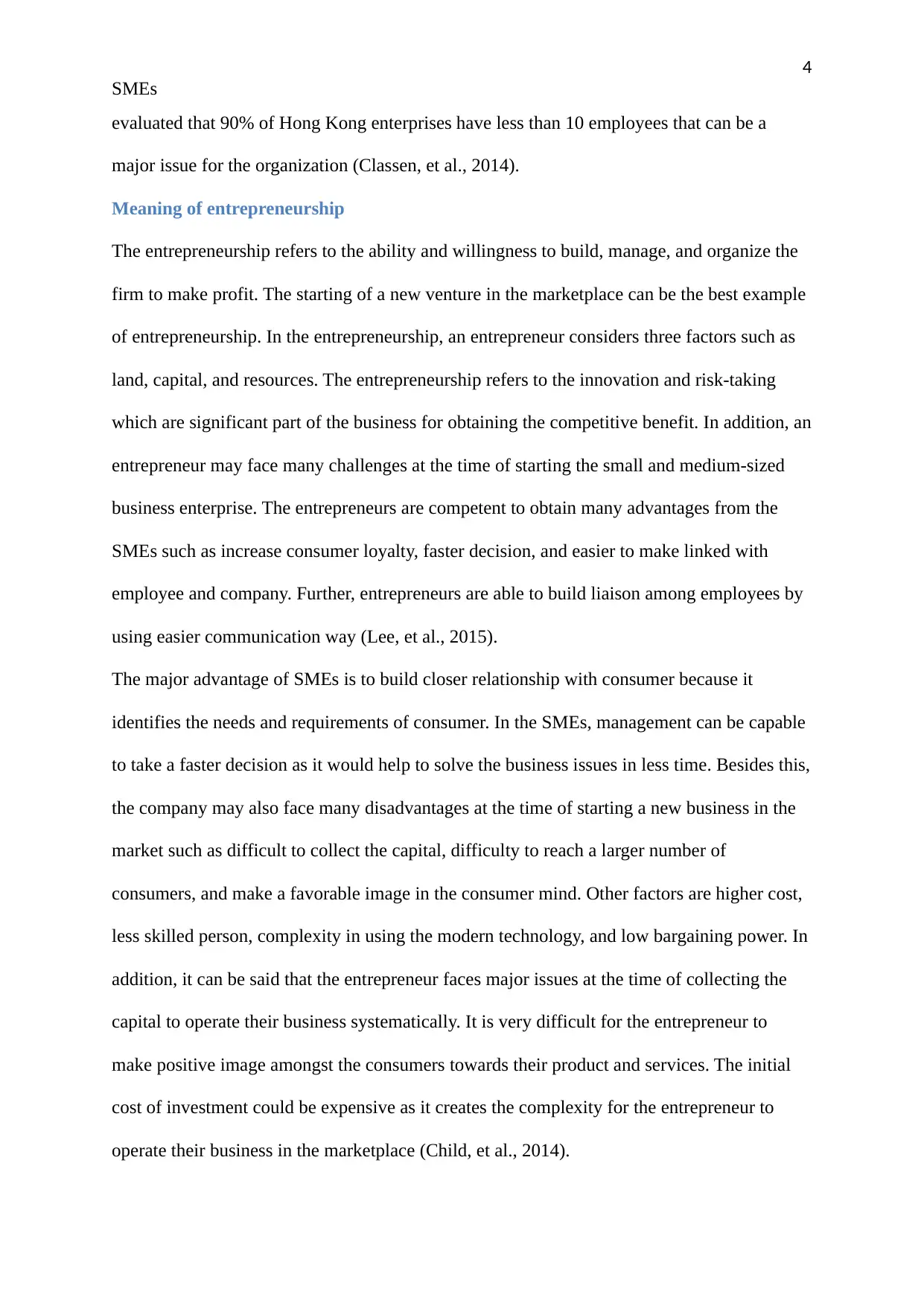
4
SMEs
evaluated that 90% of Hong Kong enterprises have less than 10 employees that can be a
major issue for the organization (Classen, et al., 2014).
Meaning of entrepreneurship
The entrepreneurship refers to the ability and willingness to build, manage, and organize the
firm to make profit. The starting of a new venture in the marketplace can be the best example
of entrepreneurship. In the entrepreneurship, an entrepreneur considers three factors such as
land, capital, and resources. The entrepreneurship refers to the innovation and risk-taking
which are significant part of the business for obtaining the competitive benefit. In addition, an
entrepreneur may face many challenges at the time of starting the small and medium-sized
business enterprise. The entrepreneurs are competent to obtain many advantages from the
SMEs such as increase consumer loyalty, faster decision, and easier to make linked with
employee and company. Further, entrepreneurs are able to build liaison among employees by
using easier communication way (Lee, et al., 2015).
The major advantage of SMEs is to build closer relationship with consumer because it
identifies the needs and requirements of consumer. In the SMEs, management can be capable
to take a faster decision as it would help to solve the business issues in less time. Besides this,
the company may also face many disadvantages at the time of starting a new business in the
market such as difficult to collect the capital, difficulty to reach a larger number of
consumers, and make a favorable image in the consumer mind. Other factors are higher cost,
less skilled person, complexity in using the modern technology, and low bargaining power. In
addition, it can be said that the entrepreneur faces major issues at the time of collecting the
capital to operate their business systematically. It is very difficult for the entrepreneur to
make positive image amongst the consumers towards their product and services. The initial
cost of investment could be expensive as it creates the complexity for the entrepreneur to
operate their business in the marketplace (Child, et al., 2014).
SMEs
evaluated that 90% of Hong Kong enterprises have less than 10 employees that can be a
major issue for the organization (Classen, et al., 2014).
Meaning of entrepreneurship
The entrepreneurship refers to the ability and willingness to build, manage, and organize the
firm to make profit. The starting of a new venture in the marketplace can be the best example
of entrepreneurship. In the entrepreneurship, an entrepreneur considers three factors such as
land, capital, and resources. The entrepreneurship refers to the innovation and risk-taking
which are significant part of the business for obtaining the competitive benefit. In addition, an
entrepreneur may face many challenges at the time of starting the small and medium-sized
business enterprise. The entrepreneurs are competent to obtain many advantages from the
SMEs such as increase consumer loyalty, faster decision, and easier to make linked with
employee and company. Further, entrepreneurs are able to build liaison among employees by
using easier communication way (Lee, et al., 2015).
The major advantage of SMEs is to build closer relationship with consumer because it
identifies the needs and requirements of consumer. In the SMEs, management can be capable
to take a faster decision as it would help to solve the business issues in less time. Besides this,
the company may also face many disadvantages at the time of starting a new business in the
market such as difficult to collect the capital, difficulty to reach a larger number of
consumers, and make a favorable image in the consumer mind. Other factors are higher cost,
less skilled person, complexity in using the modern technology, and low bargaining power. In
addition, it can be said that the entrepreneur faces major issues at the time of collecting the
capital to operate their business systematically. It is very difficult for the entrepreneur to
make positive image amongst the consumers towards their product and services. The initial
cost of investment could be expensive as it creates the complexity for the entrepreneur to
operate their business in the marketplace (Child, et al., 2014).
Paraphrase This Document
Need a fresh take? Get an instant paraphrase of this document with our AI Paraphraser
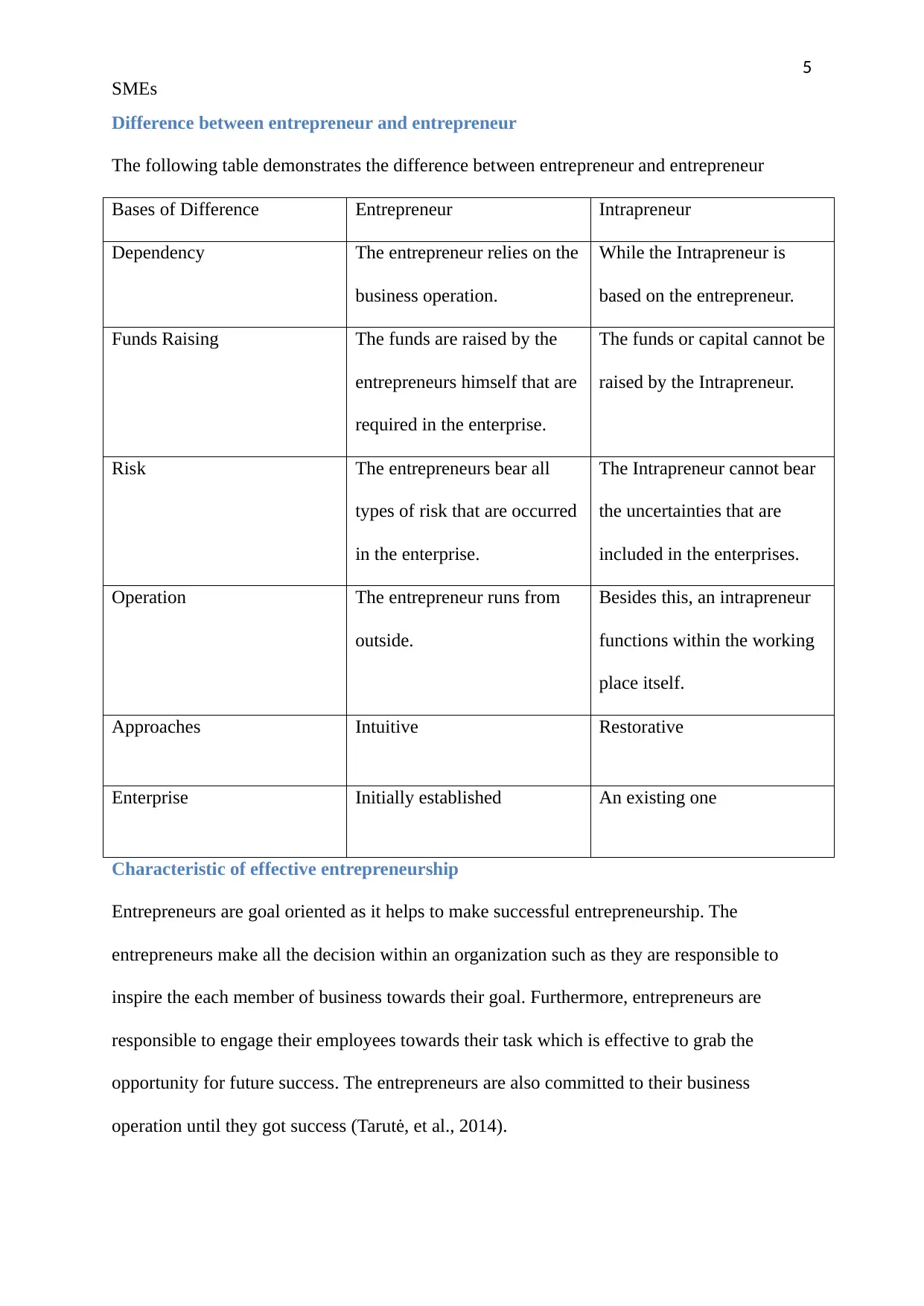
5
SMEs
Difference between entrepreneur and entrepreneur
The following table demonstrates the difference between entrepreneur and entrepreneur
Bases of Difference Entrepreneur Intrapreneur
Dependency The entrepreneur relies on the
business operation.
While the Intrapreneur is
based on the entrepreneur.
Funds Raising The funds are raised by the
entrepreneurs himself that are
required in the enterprise.
The funds or capital cannot be
raised by the Intrapreneur.
Risk The entrepreneurs bear all
types of risk that are occurred
in the enterprise.
The Intrapreneur cannot bear
the uncertainties that are
included in the enterprises.
Operation The entrepreneur runs from
outside.
Besides this, an intrapreneur
functions within the working
place itself.
Approaches Intuitive Restorative
Enterprise Initially established An existing one
Characteristic of effective entrepreneurship
Entrepreneurs are goal oriented as it helps to make successful entrepreneurship. The
entrepreneurs make all the decision within an organization such as they are responsible to
inspire the each member of business towards their goal. Furthermore, entrepreneurs are
responsible to engage their employees towards their task which is effective to grab the
opportunity for future success. The entrepreneurs are also committed to their business
operation until they got success (Tarutė, et al., 2014).
SMEs
Difference between entrepreneur and entrepreneur
The following table demonstrates the difference between entrepreneur and entrepreneur
Bases of Difference Entrepreneur Intrapreneur
Dependency The entrepreneur relies on the
business operation.
While the Intrapreneur is
based on the entrepreneur.
Funds Raising The funds are raised by the
entrepreneurs himself that are
required in the enterprise.
The funds or capital cannot be
raised by the Intrapreneur.
Risk The entrepreneurs bear all
types of risk that are occurred
in the enterprise.
The Intrapreneur cannot bear
the uncertainties that are
included in the enterprises.
Operation The entrepreneur runs from
outside.
Besides this, an intrapreneur
functions within the working
place itself.
Approaches Intuitive Restorative
Enterprise Initially established An existing one
Characteristic of effective entrepreneurship
Entrepreneurs are goal oriented as it helps to make successful entrepreneurship. The
entrepreneurs make all the decision within an organization such as they are responsible to
inspire the each member of business towards their goal. Furthermore, entrepreneurs are
responsible to engage their employees towards their task which is effective to grab the
opportunity for future success. The entrepreneurs are also committed to their business
operation until they got success (Tarutė, et al., 2014).
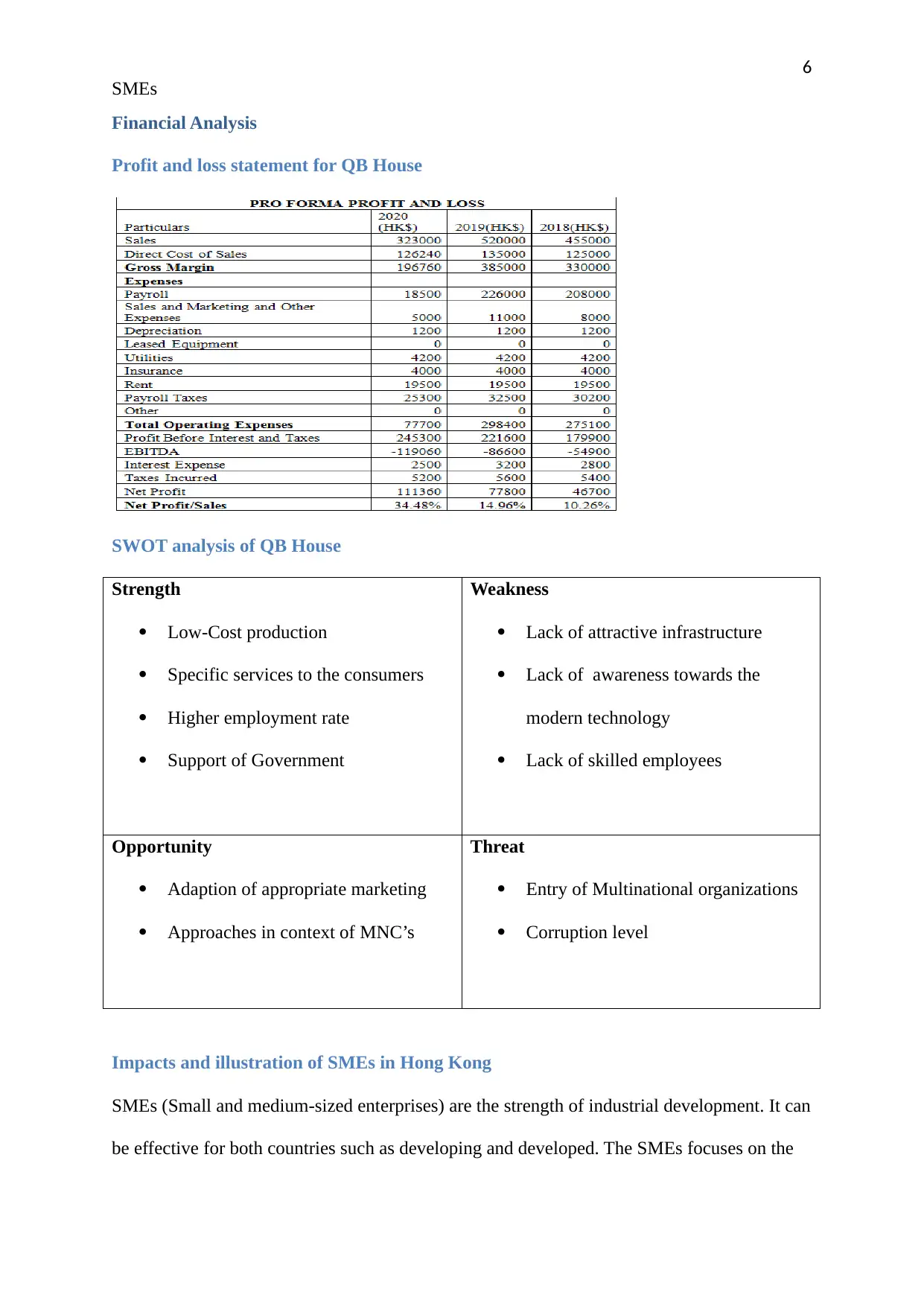
6
SMEs
Financial Analysis
Profit and loss statement for QB House
SWOT analysis of QB House
Strength
Low-Cost production
Specific services to the consumers
Higher employment rate
Support of Government
Weakness
Lack of attractive infrastructure
Lack of awareness towards the
modern technology
Lack of skilled employees
Opportunity
Adaption of appropriate marketing
Approaches in context of MNC’s
Threat
Entry of Multinational organizations
Corruption level
Impacts and illustration of SMEs in Hong Kong
SMEs (Small and medium-sized enterprises) are the strength of industrial development. It can
be effective for both countries such as developing and developed. The SMEs focuses on the
SMEs
Financial Analysis
Profit and loss statement for QB House
SWOT analysis of QB House
Strength
Low-Cost production
Specific services to the consumers
Higher employment rate
Support of Government
Weakness
Lack of attractive infrastructure
Lack of awareness towards the
modern technology
Lack of skilled employees
Opportunity
Adaption of appropriate marketing
Approaches in context of MNC’s
Threat
Entry of Multinational organizations
Corruption level
Impacts and illustration of SMEs in Hong Kong
SMEs (Small and medium-sized enterprises) are the strength of industrial development. It can
be effective for both countries such as developing and developed. The SMEs focuses on the
⊘ This is a preview!⊘
Do you want full access?
Subscribe today to unlock all pages.

Trusted by 1+ million students worldwide
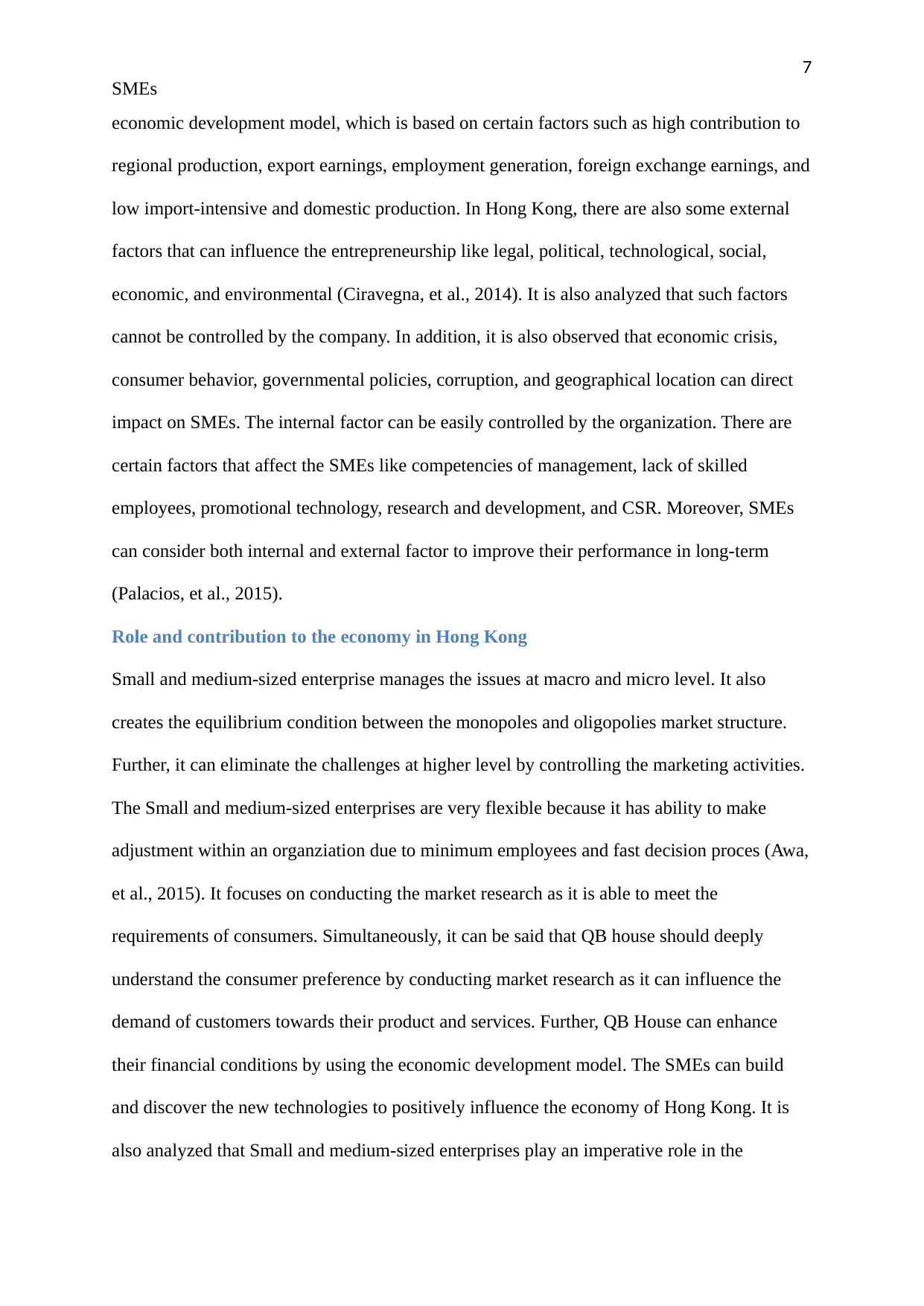
7
SMEs
economic development model, which is based on certain factors such as high contribution to
regional production, export earnings, employment generation, foreign exchange earnings, and
low import-intensive and domestic production. In Hong Kong, there are also some external
factors that can influence the entrepreneurship like legal, political, technological, social,
economic, and environmental (Ciravegna, et al., 2014). It is also analyzed that such factors
cannot be controlled by the company. In addition, it is also observed that economic crisis,
consumer behavior, governmental policies, corruption, and geographical location can direct
impact on SMEs. The internal factor can be easily controlled by the organization. There are
certain factors that affect the SMEs like competencies of management, lack of skilled
employees, promotional technology, research and development, and CSR. Moreover, SMEs
can consider both internal and external factor to improve their performance in long-term
(Palacios, et al., 2015).
Role and contribution to the economy in Hong Kong
Small and medium-sized enterprise manages the issues at macro and micro level. It also
creates the equilibrium condition between the monopoles and oligopolies market structure.
Further, it can eliminate the challenges at higher level by controlling the marketing activities.
The Small and medium-sized enterprises are very flexible because it has ability to make
adjustment within an organziation due to minimum employees and fast decision proces (Awa,
et al., 2015). It focuses on conducting the market research as it is able to meet the
requirements of consumers. Simultaneously, it can be said that QB house should deeply
understand the consumer preference by conducting market research as it can influence the
demand of customers towards their product and services. Further, QB House can enhance
their financial conditions by using the economic development model. The SMEs can build
and discover the new technologies to positively influence the economy of Hong Kong. It is
also analyzed that Small and medium-sized enterprises play an imperative role in the
SMEs
economic development model, which is based on certain factors such as high contribution to
regional production, export earnings, employment generation, foreign exchange earnings, and
low import-intensive and domestic production. In Hong Kong, there are also some external
factors that can influence the entrepreneurship like legal, political, technological, social,
economic, and environmental (Ciravegna, et al., 2014). It is also analyzed that such factors
cannot be controlled by the company. In addition, it is also observed that economic crisis,
consumer behavior, governmental policies, corruption, and geographical location can direct
impact on SMEs. The internal factor can be easily controlled by the organization. There are
certain factors that affect the SMEs like competencies of management, lack of skilled
employees, promotional technology, research and development, and CSR. Moreover, SMEs
can consider both internal and external factor to improve their performance in long-term
(Palacios, et al., 2015).
Role and contribution to the economy in Hong Kong
Small and medium-sized enterprise manages the issues at macro and micro level. It also
creates the equilibrium condition between the monopoles and oligopolies market structure.
Further, it can eliminate the challenges at higher level by controlling the marketing activities.
The Small and medium-sized enterprises are very flexible because it has ability to make
adjustment within an organziation due to minimum employees and fast decision proces (Awa,
et al., 2015). It focuses on conducting the market research as it is able to meet the
requirements of consumers. Simultaneously, it can be said that QB house should deeply
understand the consumer preference by conducting market research as it can influence the
demand of customers towards their product and services. Further, QB House can enhance
their financial conditions by using the economic development model. The SMEs can build
and discover the new technologies to positively influence the economy of Hong Kong. It is
also analyzed that Small and medium-sized enterprises play an imperative role in the
Paraphrase This Document
Need a fresh take? Get an instant paraphrase of this document with our AI Paraphraser
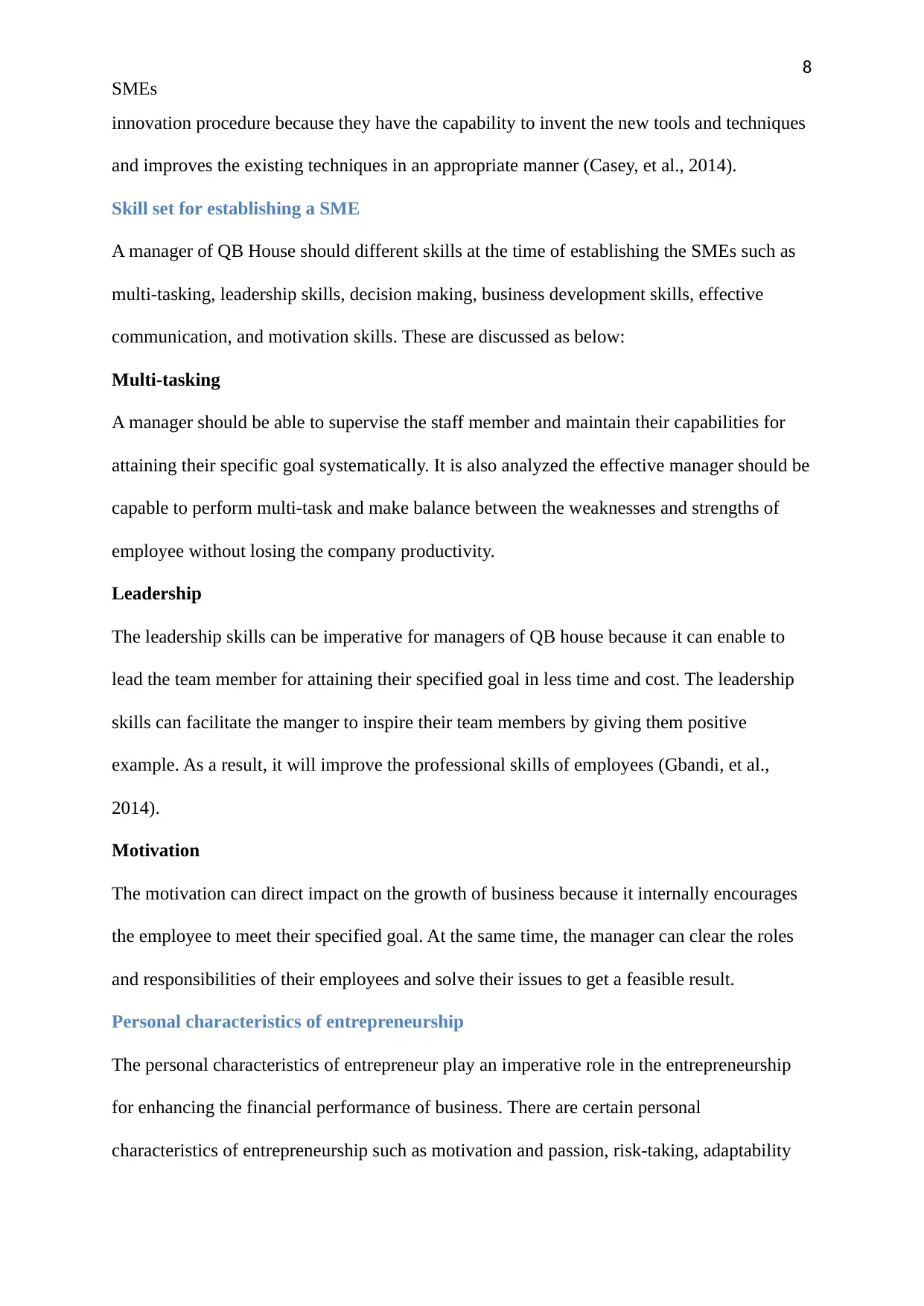
8
SMEs
innovation procedure because they have the capability to invent the new tools and techniques
and improves the existing techniques in an appropriate manner (Casey, et al., 2014).
Skill set for establishing a SME
A manager of QB House should different skills at the time of establishing the SMEs such as
multi-tasking, leadership skills, decision making, business development skills, effective
communication, and motivation skills. These are discussed as below:
Multi-tasking
A manager should be able to supervise the staff member and maintain their capabilities for
attaining their specific goal systematically. It is also analyzed the effective manager should be
capable to perform multi-task and make balance between the weaknesses and strengths of
employee without losing the company productivity.
Leadership
The leadership skills can be imperative for managers of QB house because it can enable to
lead the team member for attaining their specified goal in less time and cost. The leadership
skills can facilitate the manger to inspire their team members by giving them positive
example. As a result, it will improve the professional skills of employees (Gbandi, et al.,
2014).
Motivation
The motivation can direct impact on the growth of business because it internally encourages
the employee to meet their specified goal. At the same time, the manager can clear the roles
and responsibilities of their employees and solve their issues to get a feasible result.
Personal characteristics of entrepreneurship
The personal characteristics of entrepreneur play an imperative role in the entrepreneurship
for enhancing the financial performance of business. There are certain personal
characteristics of entrepreneurship such as motivation and passion, risk-taking, adaptability
SMEs
innovation procedure because they have the capability to invent the new tools and techniques
and improves the existing techniques in an appropriate manner (Casey, et al., 2014).
Skill set for establishing a SME
A manager of QB House should different skills at the time of establishing the SMEs such as
multi-tasking, leadership skills, decision making, business development skills, effective
communication, and motivation skills. These are discussed as below:
Multi-tasking
A manager should be able to supervise the staff member and maintain their capabilities for
attaining their specific goal systematically. It is also analyzed the effective manager should be
capable to perform multi-task and make balance between the weaknesses and strengths of
employee without losing the company productivity.
Leadership
The leadership skills can be imperative for managers of QB house because it can enable to
lead the team member for attaining their specified goal in less time and cost. The leadership
skills can facilitate the manger to inspire their team members by giving them positive
example. As a result, it will improve the professional skills of employees (Gbandi, et al.,
2014).
Motivation
The motivation can direct impact on the growth of business because it internally encourages
the employee to meet their specified goal. At the same time, the manager can clear the roles
and responsibilities of their employees and solve their issues to get a feasible result.
Personal characteristics of entrepreneurship
The personal characteristics of entrepreneur play an imperative role in the entrepreneurship
for enhancing the financial performance of business. There are certain personal
characteristics of entrepreneurship such as motivation and passion, risk-taking, adaptability
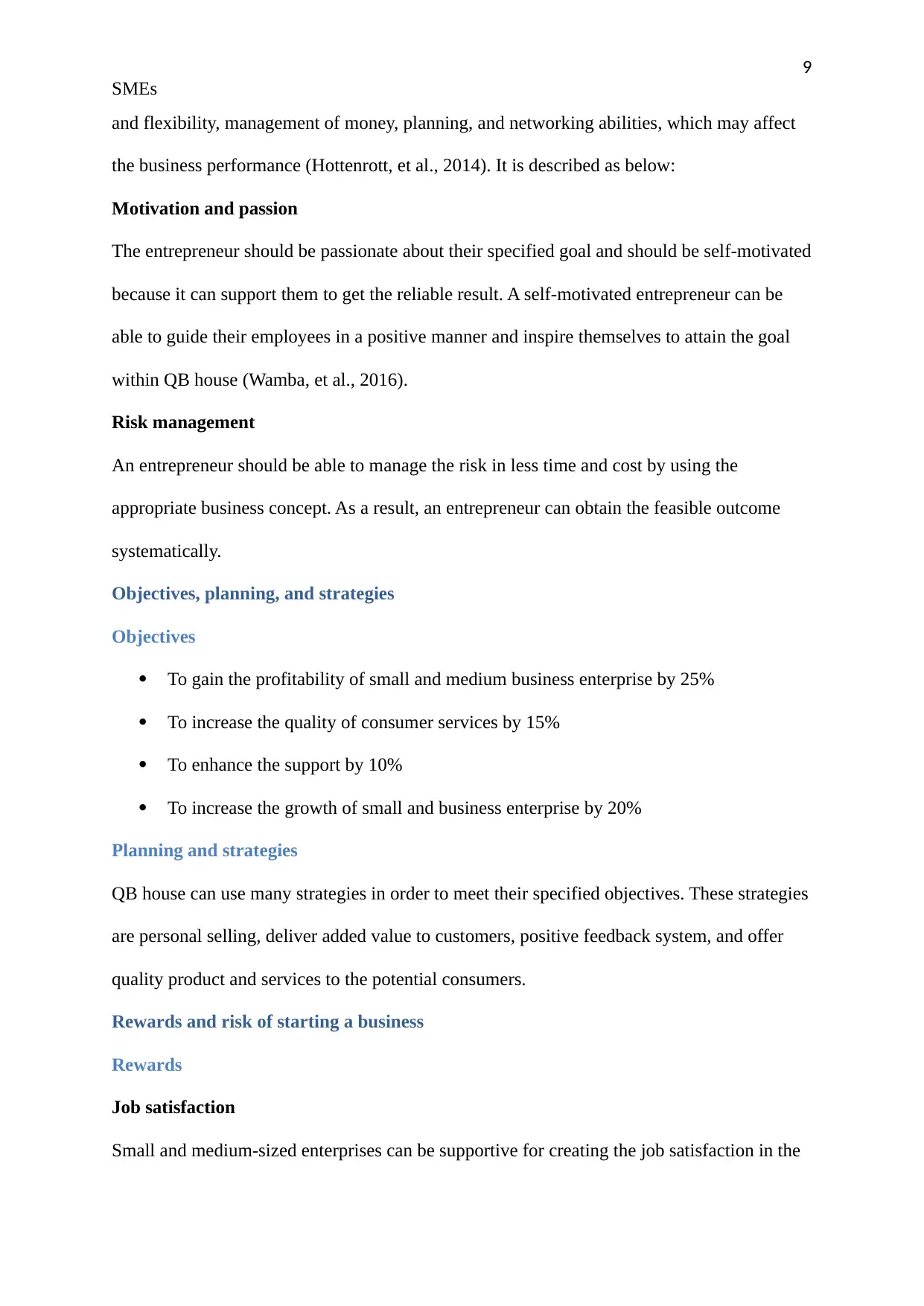
9
SMEs
and flexibility, management of money, planning, and networking abilities, which may affect
the business performance (Hottenrott, et al., 2014). It is described as below:
Motivation and passion
The entrepreneur should be passionate about their specified goal and should be self-motivated
because it can support them to get the reliable result. A self-motivated entrepreneur can be
able to guide their employees in a positive manner and inspire themselves to attain the goal
within QB house (Wamba, et al., 2016).
Risk management
An entrepreneur should be able to manage the risk in less time and cost by using the
appropriate business concept. As a result, an entrepreneur can obtain the feasible outcome
systematically.
Objectives, planning, and strategies
Objectives
To gain the profitability of small and medium business enterprise by 25%
To increase the quality of consumer services by 15%
To enhance the support by 10%
To increase the growth of small and business enterprise by 20%
Planning and strategies
QB house can use many strategies in order to meet their specified objectives. These strategies
are personal selling, deliver added value to customers, positive feedback system, and offer
quality product and services to the potential consumers.
Rewards and risk of starting a business
Rewards
Job satisfaction
Small and medium-sized enterprises can be supportive for creating the job satisfaction in the
SMEs
and flexibility, management of money, planning, and networking abilities, which may affect
the business performance (Hottenrott, et al., 2014). It is described as below:
Motivation and passion
The entrepreneur should be passionate about their specified goal and should be self-motivated
because it can support them to get the reliable result. A self-motivated entrepreneur can be
able to guide their employees in a positive manner and inspire themselves to attain the goal
within QB house (Wamba, et al., 2016).
Risk management
An entrepreneur should be able to manage the risk in less time and cost by using the
appropriate business concept. As a result, an entrepreneur can obtain the feasible outcome
systematically.
Objectives, planning, and strategies
Objectives
To gain the profitability of small and medium business enterprise by 25%
To increase the quality of consumer services by 15%
To enhance the support by 10%
To increase the growth of small and business enterprise by 20%
Planning and strategies
QB house can use many strategies in order to meet their specified objectives. These strategies
are personal selling, deliver added value to customers, positive feedback system, and offer
quality product and services to the potential consumers.
Rewards and risk of starting a business
Rewards
Job satisfaction
Small and medium-sized enterprises can be supportive for creating the job satisfaction in the
⊘ This is a preview!⊘
Do you want full access?
Subscribe today to unlock all pages.

Trusted by 1+ million students worldwide
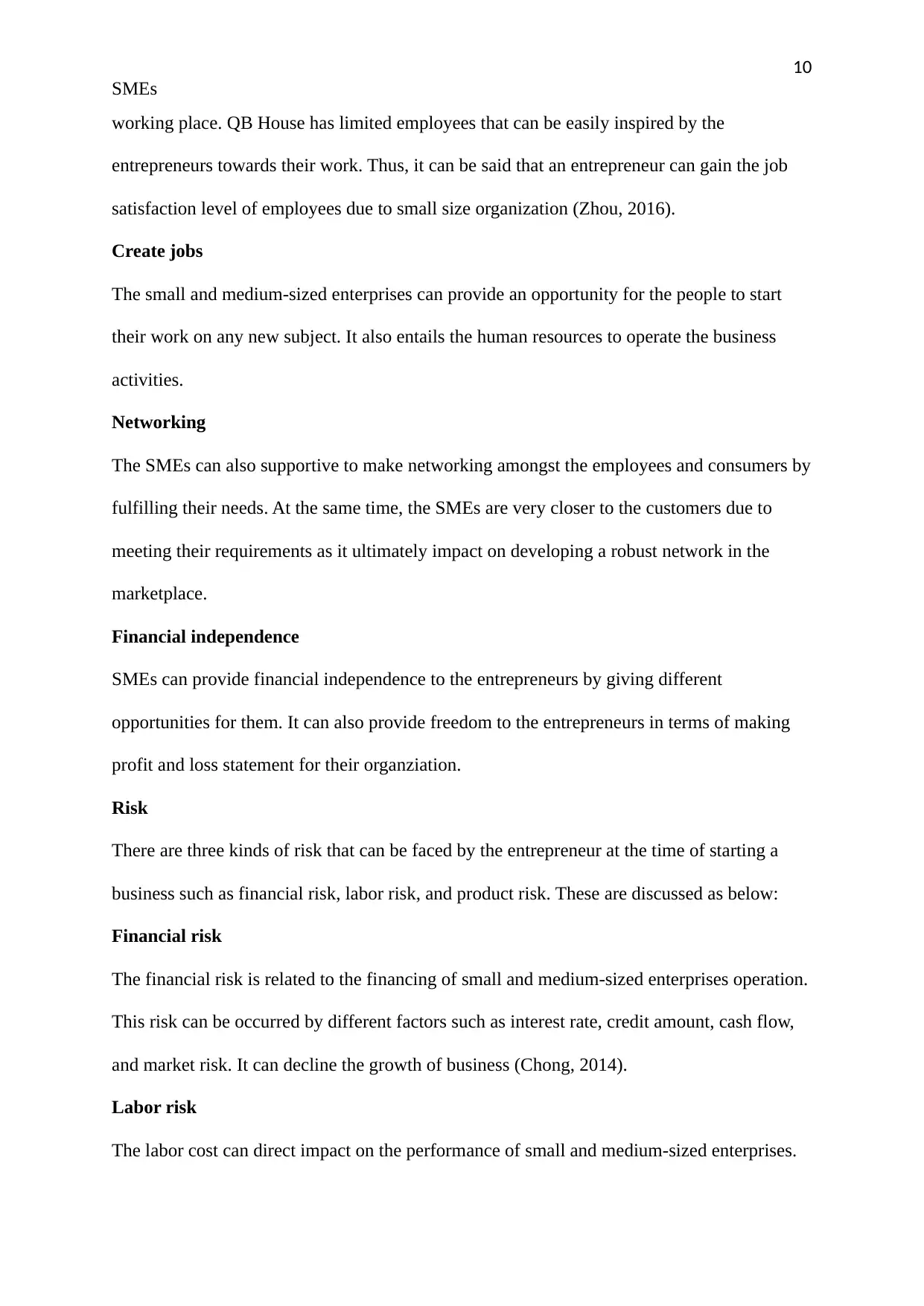
10
SMEs
working place. QB House has limited employees that can be easily inspired by the
entrepreneurs towards their work. Thus, it can be said that an entrepreneur can gain the job
satisfaction level of employees due to small size organization (Zhou, 2016).
Create jobs
The small and medium-sized enterprises can provide an opportunity for the people to start
their work on any new subject. It also entails the human resources to operate the business
activities.
Networking
The SMEs can also supportive to make networking amongst the employees and consumers by
fulfilling their needs. At the same time, the SMEs are very closer to the customers due to
meeting their requirements as it ultimately impact on developing a robust network in the
marketplace.
Financial independence
SMEs can provide financial independence to the entrepreneurs by giving different
opportunities for them. It can also provide freedom to the entrepreneurs in terms of making
profit and loss statement for their organziation.
Risk
There are three kinds of risk that can be faced by the entrepreneur at the time of starting a
business such as financial risk, labor risk, and product risk. These are discussed as below:
Financial risk
The financial risk is related to the financing of small and medium-sized enterprises operation.
This risk can be occurred by different factors such as interest rate, credit amount, cash flow,
and market risk. It can decline the growth of business (Chong, 2014).
Labor risk
The labor cost can direct impact on the performance of small and medium-sized enterprises.
SMEs
working place. QB House has limited employees that can be easily inspired by the
entrepreneurs towards their work. Thus, it can be said that an entrepreneur can gain the job
satisfaction level of employees due to small size organization (Zhou, 2016).
Create jobs
The small and medium-sized enterprises can provide an opportunity for the people to start
their work on any new subject. It also entails the human resources to operate the business
activities.
Networking
The SMEs can also supportive to make networking amongst the employees and consumers by
fulfilling their needs. At the same time, the SMEs are very closer to the customers due to
meeting their requirements as it ultimately impact on developing a robust network in the
marketplace.
Financial independence
SMEs can provide financial independence to the entrepreneurs by giving different
opportunities for them. It can also provide freedom to the entrepreneurs in terms of making
profit and loss statement for their organziation.
Risk
There are three kinds of risk that can be faced by the entrepreneur at the time of starting a
business such as financial risk, labor risk, and product risk. These are discussed as below:
Financial risk
The financial risk is related to the financing of small and medium-sized enterprises operation.
This risk can be occurred by different factors such as interest rate, credit amount, cash flow,
and market risk. It can decline the growth of business (Chong, 2014).
Labor risk
The labor cost can direct impact on the performance of small and medium-sized enterprises.
Paraphrase This Document
Need a fresh take? Get an instant paraphrase of this document with our AI Paraphraser
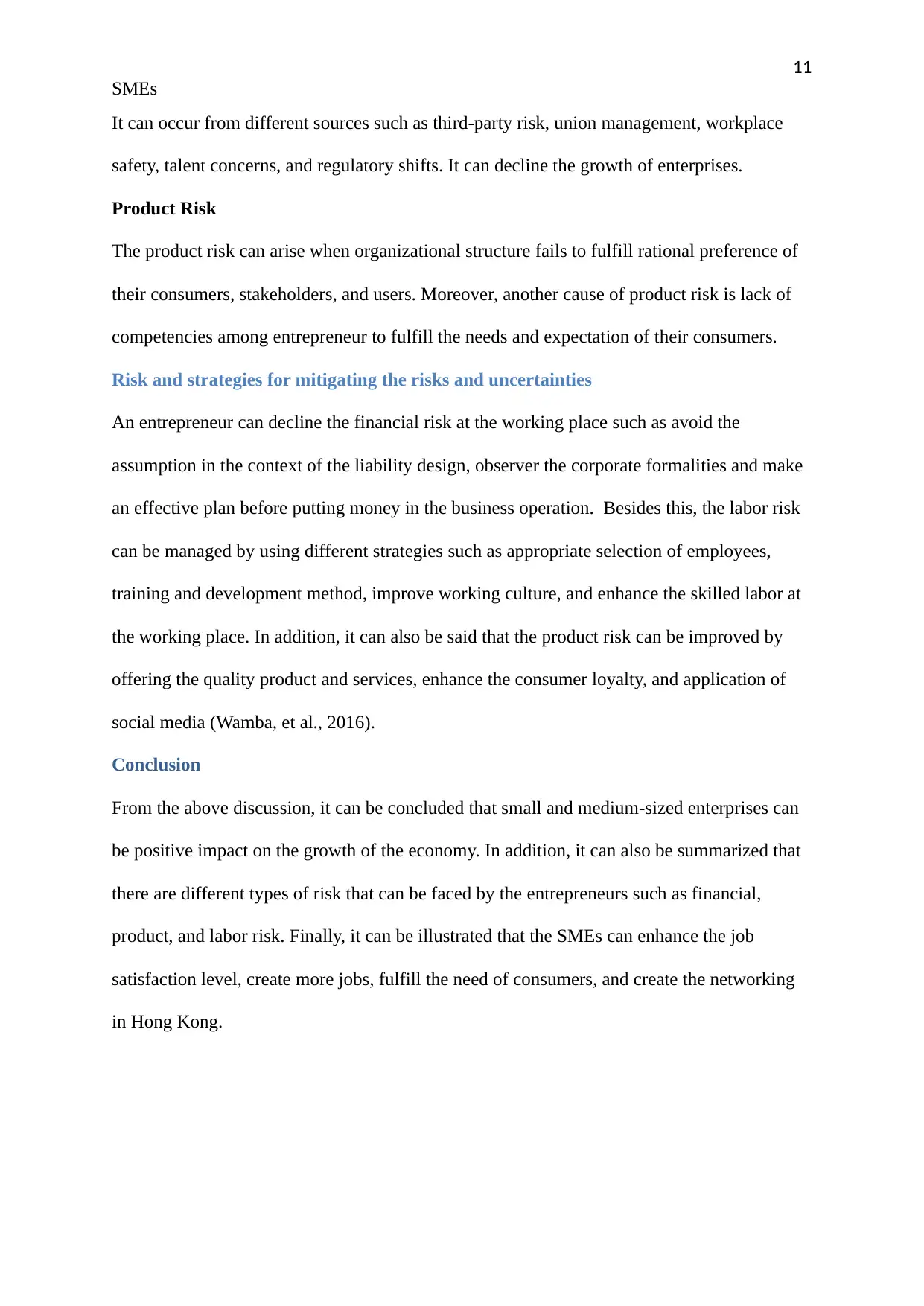
11
SMEs
It can occur from different sources such as third-party risk, union management, workplace
safety, talent concerns, and regulatory shifts. It can decline the growth of enterprises.
Product Risk
The product risk can arise when organizational structure fails to fulfill rational preference of
their consumers, stakeholders, and users. Moreover, another cause of product risk is lack of
competencies among entrepreneur to fulfill the needs and expectation of their consumers.
Risk and strategies for mitigating the risks and uncertainties
An entrepreneur can decline the financial risk at the working place such as avoid the
assumption in the context of the liability design, observer the corporate formalities and make
an effective plan before putting money in the business operation. Besides this, the labor risk
can be managed by using different strategies such as appropriate selection of employees,
training and development method, improve working culture, and enhance the skilled labor at
the working place. In addition, it can also be said that the product risk can be improved by
offering the quality product and services, enhance the consumer loyalty, and application of
social media (Wamba, et al., 2016).
Conclusion
From the above discussion, it can be concluded that small and medium-sized enterprises can
be positive impact on the growth of the economy. In addition, it can also be summarized that
there are different types of risk that can be faced by the entrepreneurs such as financial,
product, and labor risk. Finally, it can be illustrated that the SMEs can enhance the job
satisfaction level, create more jobs, fulfill the need of consumers, and create the networking
in Hong Kong.
SMEs
It can occur from different sources such as third-party risk, union management, workplace
safety, talent concerns, and regulatory shifts. It can decline the growth of enterprises.
Product Risk
The product risk can arise when organizational structure fails to fulfill rational preference of
their consumers, stakeholders, and users. Moreover, another cause of product risk is lack of
competencies among entrepreneur to fulfill the needs and expectation of their consumers.
Risk and strategies for mitigating the risks and uncertainties
An entrepreneur can decline the financial risk at the working place such as avoid the
assumption in the context of the liability design, observer the corporate formalities and make
an effective plan before putting money in the business operation. Besides this, the labor risk
can be managed by using different strategies such as appropriate selection of employees,
training and development method, improve working culture, and enhance the skilled labor at
the working place. In addition, it can also be said that the product risk can be improved by
offering the quality product and services, enhance the consumer loyalty, and application of
social media (Wamba, et al., 2016).
Conclusion
From the above discussion, it can be concluded that small and medium-sized enterprises can
be positive impact on the growth of the economy. In addition, it can also be summarized that
there are different types of risk that can be faced by the entrepreneurs such as financial,
product, and labor risk. Finally, it can be illustrated that the SMEs can enhance the job
satisfaction level, create more jobs, fulfill the need of consumers, and create the networking
in Hong Kong.
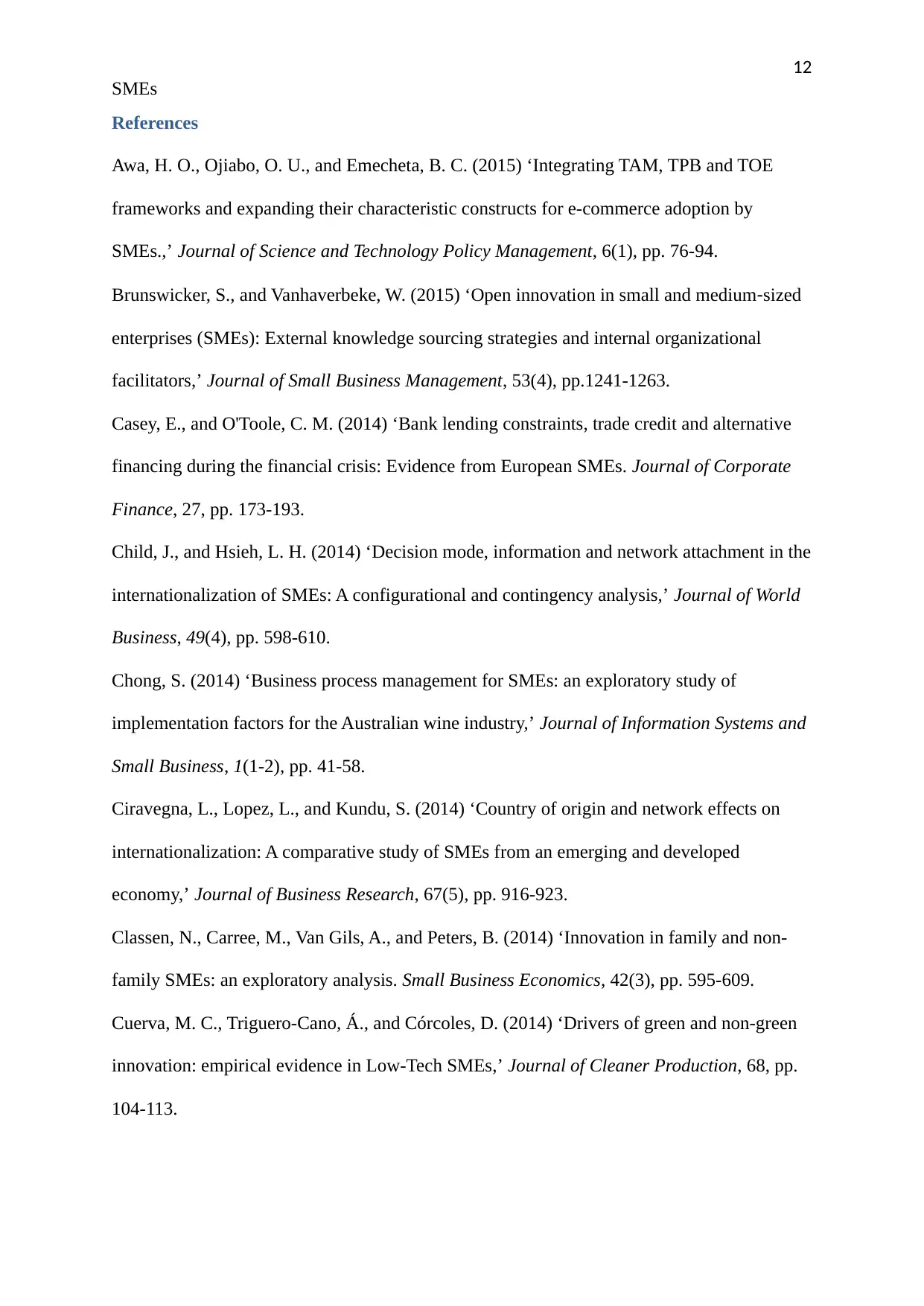
12
SMEs
References
Awa, H. O., Ojiabo, O. U., and Emecheta, B. C. (2015) ‘Integrating TAM, TPB and TOE
frameworks and expanding their characteristic constructs for e-commerce adoption by
SMEs.,’ Journal of Science and Technology Policy Management, 6(1), pp. 76-94.
Brunswicker, S., and Vanhaverbeke, W. (2015) ‘Open innovation in small and medium‐sized
enterprises (SMEs): External knowledge sourcing strategies and internal organizational
facilitators,’ Journal of Small Business Management, 53(4), pp.1241-1263.
Casey, E., and O'Toole, C. M. (2014) ‘Bank lending constraints, trade credit and alternative
financing during the financial crisis: Evidence from European SMEs. Journal of Corporate
Finance, 27, pp. 173-193.
Child, J., and Hsieh, L. H. (2014) ‘Decision mode, information and network attachment in the
internationalization of SMEs: A configurational and contingency analysis,’ Journal of World
Business, 49(4), pp. 598-610.
Chong, S. (2014) ‘Business process management for SMEs: an exploratory study of
implementation factors for the Australian wine industry,’ Journal of Information Systems and
Small Business, 1(1-2), pp. 41-58.
Ciravegna, L., Lopez, L., and Kundu, S. (2014) ‘Country of origin and network effects on
internationalization: A comparative study of SMEs from an emerging and developed
economy,’ Journal of Business Research, 67(5), pp. 916-923.
Classen, N., Carree, M., Van Gils, A., and Peters, B. (2014) ‘Innovation in family and non-
family SMEs: an exploratory analysis. Small Business Economics, 42(3), pp. 595-609.
Cuerva, M. C., Triguero-Cano, Á., and Córcoles, D. (2014) ‘Drivers of green and non-green
innovation: empirical evidence in Low-Tech SMEs,’ Journal of Cleaner Production, 68, pp.
104-113.
SMEs
References
Awa, H. O., Ojiabo, O. U., and Emecheta, B. C. (2015) ‘Integrating TAM, TPB and TOE
frameworks and expanding their characteristic constructs for e-commerce adoption by
SMEs.,’ Journal of Science and Technology Policy Management, 6(1), pp. 76-94.
Brunswicker, S., and Vanhaverbeke, W. (2015) ‘Open innovation in small and medium‐sized
enterprises (SMEs): External knowledge sourcing strategies and internal organizational
facilitators,’ Journal of Small Business Management, 53(4), pp.1241-1263.
Casey, E., and O'Toole, C. M. (2014) ‘Bank lending constraints, trade credit and alternative
financing during the financial crisis: Evidence from European SMEs. Journal of Corporate
Finance, 27, pp. 173-193.
Child, J., and Hsieh, L. H. (2014) ‘Decision mode, information and network attachment in the
internationalization of SMEs: A configurational and contingency analysis,’ Journal of World
Business, 49(4), pp. 598-610.
Chong, S. (2014) ‘Business process management for SMEs: an exploratory study of
implementation factors for the Australian wine industry,’ Journal of Information Systems and
Small Business, 1(1-2), pp. 41-58.
Ciravegna, L., Lopez, L., and Kundu, S. (2014) ‘Country of origin and network effects on
internationalization: A comparative study of SMEs from an emerging and developed
economy,’ Journal of Business Research, 67(5), pp. 916-923.
Classen, N., Carree, M., Van Gils, A., and Peters, B. (2014) ‘Innovation in family and non-
family SMEs: an exploratory analysis. Small Business Economics, 42(3), pp. 595-609.
Cuerva, M. C., Triguero-Cano, Á., and Córcoles, D. (2014) ‘Drivers of green and non-green
innovation: empirical evidence in Low-Tech SMEs,’ Journal of Cleaner Production, 68, pp.
104-113.
⊘ This is a preview!⊘
Do you want full access?
Subscribe today to unlock all pages.

Trusted by 1+ million students worldwide
1 out of 14
Related Documents
Your All-in-One AI-Powered Toolkit for Academic Success.
+13062052269
info@desklib.com
Available 24*7 on WhatsApp / Email
![[object Object]](/_next/static/media/star-bottom.7253800d.svg)
Unlock your academic potential
Copyright © 2020–2025 A2Z Services. All Rights Reserved. Developed and managed by ZUCOL.


